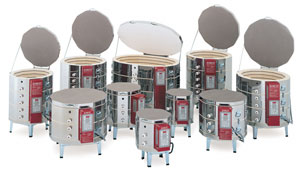Red is one of the most popular colours to be used worldwide. The color red is associated with lust, passion, love, beauty, and danger. In Asia it is a symbol of courage, loyalty, honor, success, fortune, fertility, happiness, passion, and summer.
Consequently many types of asian pottery including the beautiful chinese red glazes of the Sung Dynasty and the exquisite Japanese Imari porcelain feature red as the main colour.
However in more recent times the demand for mass produced red pottery of high intensity and consistent colour has created a real challenge for ceramic engineers involved in pottery manufacture.
Japanese Red
Imari porcelain is the name for Japanese porcelain wares made in the town of Arita, in the former Hizen Province, northwestern Kyūshū. They were exported to Europe extensively from the port of Imari, Saga between latter half of 17th century and former half of 18th century.
 |
| Photo of Imari by George Le Gars |
The blue is rich in colour and hue and is based on a cobalt containing pigment. The red colour, however, whilst remarkably bright and interesting is not such a clean hue and is produced using iron oxide or iron based ceramic pigments.
Iron ochres and natural red clays are some of the earliest pigments used by man and continue to be used today particularly in hand crafted pottery of rustic nature.
Rouge Flambe
Similarly many of the early ceramic red colours and glazes used on European pottery were not always pure in colour and were based on copper or gold in colloidal form. These colours were used to copy original Chinese patterns and glazes perfected in the 18th century.
 |
| Rouge Flambe by Royal Doulton Co |
In Britain, the Staffordshire potter Bernard Moore used experimental and highly accomplished red flambe glazes on Chinese-inspired shapes to wonderful effect. Requiring a special glaze formula, firing cycle and condition they were expensive to manufacture and difficult to reproduce.
Shown here is a vase made by Royal Doulton decorated with the spectacular Rouge Flambe glaze.
The Challenge of Pillar Box Red
 |
| Red Pillar Box by Ian Britton FreeFoto.com |
In particular the large scale development and manufacture of pillar box red colour and glaze for pottery is believed to have taken over eight thousand years to achieve. It was not until the twentieth century that true pillar box red glazes and onglaze colours became widely available for decoration of pottery.
Cadmium Sulpho-Selenide Red Glazes
To overcome this the cadmium was added to the frit batch and subsequently melted into a glassy state. In many cases the frits also contained lead, sulphur and selenium. This type of glaze required firing in a specific way to achieve optimum results. The firing time and the kiln atmosphere were both critical. The best results were obtained using a short firing cycle to a peak temperature of approximately 1000C. Good air circulation in the kiln, and a good separation of pieces were also recommended. Ideally Cd/Se fritted glazes should be fired separately from other types of ware, because fumes from other coloured glazes can affect the colour achieved.
First generation Zircon/ Cadmium Red Glazes
 |
| Actual Red |
 |
| Target Red |
In the 1970s ceramic engineers in Europe developed a new generation of red colours and glazes. These were totally different in nature as they were based on a zircon encapsulated cadmium pigment. These were patented in 1973 by Broll et al of Degussa.
Briefly encapsulation means that at microscopic level the cadmium is surrounded by the zircon crystal. This gives two major advantages. The pigment is more temperature stable up to 1200 celsius and more chemically stable thus giving lower cadmium release after firing and exposure to acids. These types of red glaze could be used on a variety of firing schedules and were infinitely more flexible in use.
However these pigments had a serious drawback which limited their widespread use. They lacked intensity and consequently needed high pigment loading to give any degree of colour saturation.
Second and third generation Zircon/ Cadmium Red Glazes
 |
| Red Vase by Newland Pottery BV |
China is the major manufacturer of these types of pigment as they have proven to be a lower cost supplier of intense encapsulate pigments.
The challenge of the stable pillar box red glaze now appears to have been met by ceramic engineers. The stable cadmium encapsulate pigment is being used by most pottery manufacturers and appears to meet current legislation in many parts of the world. However cadmium is still an emotive word for many being considered a toxic element in much the same way lead. So who knows? Will the journey to find a new pillar box red start all over again? What do you think?
This article was inspired by the recent publication of a book entitled THE DEFIANT RED by my friend the highly respected ceramic expert Leen W Baaij.
More information and other technical articles on pottery and ceramics can be found at my website The Potters Friend. Go now to sign up for my free newsletter.















